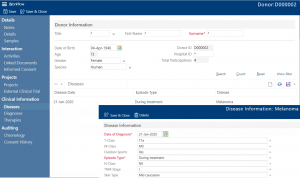The fundamental role of Biobanks is to provide quality biological samples to help further research. Ultimately helping shape new vaccines and cures for diseases. Your Biobank might include historical samples as well as current ones. As a disease-specific Biobank the profile data you hold about your participants is as important as the information about your samples. Being able to hold disease-specific information against each participant in your Biobank helps you build up a greater understanding of your samples. This can have a significant impact on research outcomes. Plus, being able to add to the data as you discover more about the person and the disease means you’re continuing to develop even more valuable insight.
Achiever Medical’s core LIMS functionality enables you to manage your disease-specific collections. As well as record detailed profile information about your participants, their diseases and their samples. All this helps researchers find the samples they need. What’s more it helps you make sure you use every sample in a way that achieves optimum results. Making Every Sample Matter.
Defining disease projects and collections

Being a disease-specific Biobank doesn’t mean you only hold biological samples relating to one disease. You may hold several disease-specific sample collections in your Biobank.
Achiever Medical’s project management functionality helps you manage these different disease-specific collections. You can define different projects for each individual collection and associate a project team and sample storage locations. You can also link protocol, consent and ethics approval documentation.
Once you have defined a project you then assign its participants and samples. Only those users that have active roles on the project team are able to work with and use those linked samples. Plus, you can choose who can see personal identifiable information (PII) for associated participants. Also because you’ve ring-fenced storage by linking it to your project you can manage which sample collections are held in there.
If you need to further segment your collection, you can create studies against it. You then choose which samples to allocate to your study. Each study has its own team members and associated roles. This means that you can elevate selected users’ permissions for this subset of samples only.
Collaboration is key to success
When it comes to research and conquering diseases collaboration is key. This could be with researchers within your own institute or working with partner organisations. Within Achiever Medical you can choose whether to make the samples on the collection available for loan. This allows others who are not directly working on your projects or studies to request your samples for use.
Plus, Achiever Medical’s online sample request portal enables authorised researchers to search your selected collections and request samples.
What’s more because Achiever Medical is web- and project-based you can allow external researchers secure access to work on samples within specific collections. So, they’re acting as an extension of your own team and you’re running truly collaborative research projects and studies.
Capturing disease-specific data in LIMS

Achiever Medical’s disease management functionality enables you to manage multiple diseases and define the data you want to capture against each different disease. Each disease may have very specific characteristics and stages – all of which you can define. You can even determine what information is mandatory for each disease and set picklist options to ensure data is recorded consistently.
Plus, you can easily add new fields to hold more information about the participant and disease as your knowledge and research develops. All of this data can be searched and analysed.
In addition, you can capture disease episode information against participants. This allows you to track the progress of the disease and any significant changes. You can tie this information to samples collected against the participant during particular visits.
Patient profiling information
You also can build up a more detailed picture about each person by storing lifestyle, demographic, treatment and diagnosis data. This allows researchers to be even more targeted when searching for samples to use. Plus, this data can be used to spot common traits or characteristics that could offer vital clues about the disease.
Using Achiever Medical’s extensive and flexible configuration tools you can easily add any additional participant profiling fields as required.
A final thought on how Achiever Medical LIMS helps you manage disease-specific Biobanks
When running disease-specific Biobanks being able to record disease and participant profiling information is essential. Helping researchers understand more about the disease to tailor their research and possible treatments.
Being able to add new fields to hold additional data about participants and the disease as your understanding evolves will help your Biobank and samples remain relevant and valuable.
Achiever Medical’s unique project and study management tools coupled with its flexible disease and participant profiling capabilities enable your Biobank to give researchers richly annotated samples. Arming them with a wealth of data to help them fight the disease and making sure you’re using your samples for maximum effect. Making every sample matter.

Comments are closed.